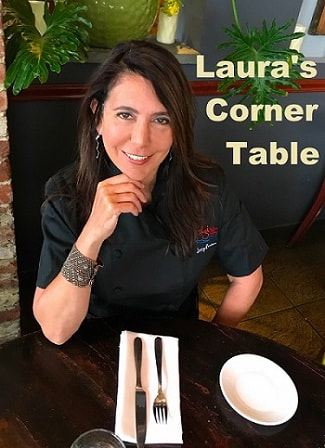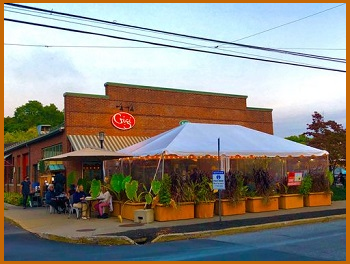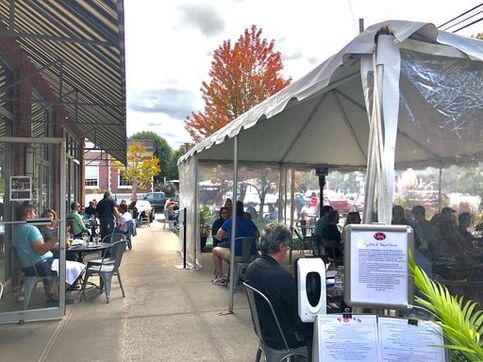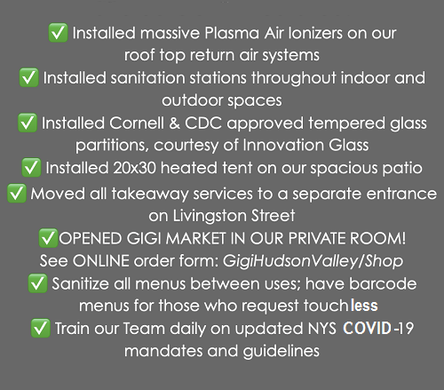|
"My journey of showing people
how to eat better (and enjoy it) has helped me to understand that spotlighting what drives others to produce great products… sharing their insights and talents… is a gift to self." ~ Laura Pensiero |
ARCHIVED COLUMNS:
August 2020 "When All Seems Lost...Laugh Until it Hurts" May 2020: "Nature Can't Stay in Place" February 2020: "Ode to Chocolate" December 2019: "Happy Healthy Holidays" May 2019: "Pull the Trigger: Your Health is What Matters Most" April 2019 "Introducing Laura Pensiero, RD" |
Living Like a Farmer:
A Restaurateur’s Journey through COVID-19
(Part II)
October 2020
|
Delicious Fall Harvest Recipe at Conclusion of Article
I’ve always had a strong connection with local food producers, particularly feeling their vulnerability to conditions beyond their control, specifically weather. And now, with the COVID-19 outbreak for most of 2020, restaurateurs are living like farmers - watching the weather daily, praying that outdoor seating continues for as long as possible. When I began my career as an “accidental” restaurateur 19 years ago, I found a significantly different Hudson Valley culinary landscape than the one we enjoy today. At this time, “farm to table” mostly meant going to the farms and local food producers and picking up products for innovative seasonal menus yourself. The upside of this was developing friendships and strong relationships with those who grew and “added value” to the food. The downside was the time investment in driving to obtain products and the multitude of invoices, typically received in “chicken scratch” that resembled doctors’ prescriptions. Since then, Hudson Valley Bounty, a directory and resource for family farmers, specialty food producers, renowned chefs, agricultural entrepreneurs and Farms2Tables, has figured out ways to network suppliers and restaurants as well as to get the amazing products to the restaurants. |
|
In 2009, I wrote my love story/anthem to this movement: Hudson Valley Mediterranean: The Gigi Good Food Cookbook (HarperCollins, 2009). This publication was far more than a cookbook to me; rather, it was a celebration of the food producers and artisans that made the very distinct four seasons in the Hudson Valley so very unique to the creativity of restaurateurs as well as those interested in the power of simplicity - good local food equals more enjoyable meals, plus better health. Throughout my writing career, I’ve most enjoyed spotlighting others - their life experiences and what drives them to do what they do.
|
Why refer to almost two decades as “accidental?” The tale is complicated, but, in short, I was married to a recognized and very talented chef when the doors opened at Gigi Trattoria. I am an organizer, doer and problem-solver, so in 2001, I was thrilled to move full-time into our then weekend home and to get to work on what would soon be Gigi Trattoria. A space on Montgomery Street was being converted to retail and restaurant use, and I saw an opportunity for my then-husband to showcase his talents close to home. The work began with building out from a stone slab within the beautiful exterior brick façade of a longtime Chevy dealer showroom. My plan at that time was to organize the opening - with the designers, architects, builders - and then resume my career as writer, nutritionist and consultant in New York City. As a culinary graduate, registered dietitian, and writer, I had a thriving consulting business, so I never imagined myself as a restaurateur, much less for almost two decades. |
Building in 2001 Before it was Transformed into Gigi Trattoria & Retail Space
|
|
Cozy and Safe: Fall Outdoor Dining
(Photo Courtesy: Gigi Trattoria) |
At the time, opening Gigi just one week after 9/11/2001, felt like the biggest hurdle the restaurant would face. Through the process of divorce in 2003, I found myself buying out my ex-husband’s majority share. The day he left, I remember the sheer terror of the sudden, complete and sole responsibility of managing all aspects of the restaurant. Although I had always been a self-motivated entrepreneur, owning a restaurant and managing people was unknown territory for me. Over the next 17 years, many more tests would come, and my confidence in my own abilities grew with each one of them; but never could I, or anyone else, expect COVID-19.
COVID-19 may be the single most devastating event to impact dining and the foodservice industry in our lifetime. Given the initial complete lockdown, then the allowance of take-away, the next phase of outdoor dining which was eventually followed by 50% capacity indoors has been highly stressful and, at many times, highly confusing with Executive Orders changing by the day and local municipalities struggling to keep up. |
In some ways, I now find myself back to where I started, walking into the unknown and a bit apprehensive. After almost two decades of weathering storms, the difference is that I am more confident in myself and my abilities to lead this restaurant that I so dearly love to the other side of this test.
Since my previous column installment in August, I (like other restaurateurs) have worked with my landlord, the local municipalities, and the State Liquor Authority to safely expand outdoor dining. In typical years, we had from March to Mother’s Day to build our service teams for the season. This year, like farmers, we had to adjust to the elements. So with only four days’ notice, we somehow managed to open!
But that very first weekend brought out the best and the worst of a difficult situation. A group of very impatient day-trippers from New York City perceived that other guests were being prioritized over them. I had walked over to the table to check in and was grilled about why another table received water first and was then unabashedly told that I didn’t know how to run a restaurant. Surrounding guests came to the rescue with a hailstorm of boos. The kindness and patience of so many as we tried to reopen in record speed will be never be forgotten.
Since my previous column installment in August, I (like other restaurateurs) have worked with my landlord, the local municipalities, and the State Liquor Authority to safely expand outdoor dining. In typical years, we had from March to Mother’s Day to build our service teams for the season. This year, like farmers, we had to adjust to the elements. So with only four days’ notice, we somehow managed to open!
But that very first weekend brought out the best and the worst of a difficult situation. A group of very impatient day-trippers from New York City perceived that other guests were being prioritized over them. I had walked over to the table to check in and was grilled about why another table received water first and was then unabashedly told that I didn’t know how to run a restaurant. Surrounding guests came to the rescue with a hailstorm of boos. The kindness and patience of so many as we tried to reopen in record speed will be never be forgotten.
|
Some years the weather gods gift farmers with just the right amount of rain and sun. This year, they blessed restaurants with warm sunny days and beautiful weekends. While I’m confident that we did all that was possible for seating guests indoors, so many were not yet psychologically ready for it. All of us in the northeast were offered a beautiful season of weather when we needed it the most.
But the autumn season was upon us… As the summer raced by, I started thinking about colder weather plans. I drew upon the many years that I had done large-scale event catering and rented a 20x30 tent. I also worked with the local government to ensure that the use of propane heat could be safely and effectively used. The tent company has promised to do necessary snow removal to keep this environment safe and toasty as long as possible. Don’t we all need a little daylight as the days grow shorter? As far as indoor dining, we’ve been gaining guest confidence by all of the measures we’ve taken, including those that go above and beyond New York State COVID-19 guidelines. While they all matter, I believe our massive rooftop Plasma Air ionization systems make the biggest impact - enabling our guests (and staff) to feel safe. The beautiful glass partitions between our socially distanced tables also give a sense of coziness and safety without isolation. But most of all, it’s our amazing team who share their smiles from under their face coverings. As this first six months of the surreal daily management of a business in 2020 comes to a close, my emotions are mixed:
I will close, though, by sharing that I am evermore respectful of our farmers and their travails! |
FALL RECIPE
Harvest Stuffed Peppers
A note on pepper selection: Peppers are abundant at summer’s end and in early autumn, which allows me to put my foot down: I make this dish only if I can get fresh picked peppers. If they do not come from my garden, then I’ll select some from a local grower. Wherever you live, think about making peppers a star component of the meal when they’re newly harvested. The difference in aroma, flavor, and texture is vastly different from the typical supermarket variety. Those huge bell peppers can serve as a holding vessel for the stuffing but don’t really contribute to the flavor of the dish. Small to medium farm-fresh peppers also tend to have much thinner walls. This means the pepper is cooked, wilted and fork ready, when the stuffing is still moist and the top golden crusted. I like a North African style of spice mix and a whole grain stuffing, with or without ground beef or pork sausage, but this dish is very versatile.
~ ~ ~
(Serves 8 as an appetizer or 4 as an entrée.)
A note on pepper selection: Peppers are abundant at summer’s end and in early autumn, which allows me to put my foot down: I make this dish only if I can get fresh picked peppers. If they do not come from my garden, then I’ll select some from a local grower. Wherever you live, think about making peppers a star component of the meal when they’re newly harvested. The difference in aroma, flavor, and texture is vastly different from the typical supermarket variety. Those huge bell peppers can serve as a holding vessel for the stuffing but don’t really contribute to the flavor of the dish. Small to medium farm-fresh peppers also tend to have much thinner walls. This means the pepper is cooked, wilted and fork ready, when the stuffing is still moist and the top golden crusted. I like a North African style of spice mix and a whole grain stuffing, with or without ground beef or pork sausage, but this dish is very versatile.
~ ~ ~
(Serves 8 as an appetizer or 4 as an entrée.)
|
Ingredients:
9 medium green bell peppers (mix in or substitute yellow or red if desired) 8 ounces crumbled sausage 1 tablespoon olive oil 1 small onion, diced ½ teaspoon ground cumin ¼ teaspoon Garam Masala ¼ teaspoon ground cinnamon ⅓ cup dried currants or cranberries ¼ cup chopped dried apricots ¼ cup white wine or water 4 cups cooked wild rice or whole grain rice blend 6 ounces soft goat cheese, crumbled (or an equal amount of feta or shredded cheddar) Salt and pepper, to taste 3 tablespoons grated Parmesan cheese |
|
|
Directions:
Preheat the oven to 375°F. Remove the stem and slice the tops off of the bell peppers. Remove the seeds and discard. Set 8 of the peppers aside. Chop the remaining pepper along with the tops of the others. Reserve the whole and chopped peppers separately. Place the sausage in a medium nonstick skillet over medium-high heat with the olive oil; cook until lightly browned. Add the onion, chopped peppers, and spices and cook, stirring often, until the onion is soft, about 3 minutes. Add the dried fruit, cook 1 minute, and stir in the white wine or water. Transfer the mixture to a large bowl and stir in the cooked rice. Fold in the goat cheese and adjust seasoning with salt and pepper, if necessary. Stuff each pepper with filling and place in a lightly oiled baking dish just large enough to hold them in a single layer. Cover with aluminum foil wrap, using enough foil to create a tent, so that the edges can be sealed but the top does not touch the tops of the peppers. Bake for 40 minutes, then remove the foil and sprinkle the tops with the Parmesan. Cook another 10 minutes, or until the tops are lightly browned and the peppers are tender. Recipe from: Hudson Valley Mediterranean: The Gigi Good Food Cookbook (HarperCollins) © 2009 Laura Pensiero |
Variations:
Wild rice provides ample folate (and other B vitamins), vitamin E, iron, vitamin K, fiber, and protein. It has more protein, four times as much vitamin E and six times as much as folate as brown rice. Peppers are an excellent source of vitamins A and C, both powerful antioxidants. They are also a very good source of potassium. If you delay harvesting peppers on the plant until they mature from green to red (or purple), they’ll have 10 times the vitamin A and double the vitamin C. |
Laura Pensiero is Sanctuary's nutrition columnist and the founder, chef/owner and creative force behind Gigi Hudson Valley (Gigi Trattoria and Gigi Catering). She is the author of Hudson Valley Mediterranean and co-author of The Strang Cancer Prevention Center Cookbook. Find out more about Laura by reading her interview with Sanctuary HERE.







